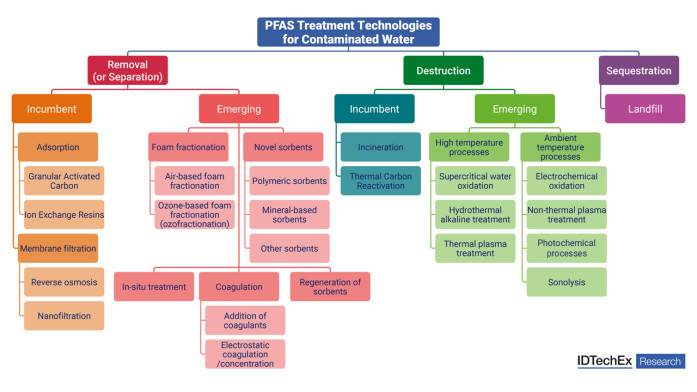
BOSTON, MA / ACCESSWIRE / November 12, 2024 / The presence of per- and polyfluoroalkyl substances (PFAS) in global drinking water is a growing concern due to their harmful health and environmental impacts. PFAS are both persistent and bioaccumulative, requiring active intervention through treatment technologies to remove them from water. IDTechEx's market report, "PFAS Treatment 2025-2035: Technologies, Regulations, Players, Applications", provides an in-depth look at these solutions.

Landscape of PFAS treatment technologies for contaminated water. Source: IDTechEx
Author of the report, IDTechEx Senior Technology Analyst Sona Dadhania, explains that: "Established water treatment technologies can be utilized to effectively remove the most commonly regulated PFAS, like PFOA (perfluorooctanoic acid) and PFOS (perfluorooctane sulfonic acid), from groundwater and surface water. While these technologies are effective at removing PFAS from the environment, they cannot guarantee that captured PFAS is permanently removed from the environment, because they do not destroy the captured PFAS. Many advocates are concerned that removed PFAS may find its way back into the environment, creating a never-ending cycle of PFAS removal. For example, spent adsorption media (i.e. spent GAC, IER) that is landfilled could leach captured PFAS into the ground, allowing for previously removed PFAS to re-enter the environment. This creates a need for another category of PFAS treatment technologies to ensure that captured PFAS can never return to the environment: PFAS destruction technologies."
Dadhania advises that concerns over incumbent strategies for PFAS waste management have created opportunities for novel PFAS destruction technologies to potentially disrupt the status quo. Numerous different destruction technologies are being developed by universities and independent start-ups.
Concerns surrounding the incineration and landfilling of PFAS have supported the emergence of new PFAS destruction technologies, but there are other factors impacting its potential growth. The most important of these factors is regulations. While the reluctance from US regulatory authorities to fully support incineration has afforded emerging PFAS destruction technologies an opportunity to displace incineration, the lack of a permanent ban on incineration presents obstacles to its growth. Changes in regulations surrounding incineration of PFAS will be key to watch for the future trajectory of this field.
IDTechEx's report, "PFAS Treatment 2025-2035: Technologies, Regulations, Players, Applications", provides a detailed evaluation of both established and emerging PFAS treatment technologies across various applications. The report includes player landscapes, a 10-year market forecast for municipal drinking water treatment, and in-depth analysis of the evolving PFAS treatment market. The comprehensive discussion and analysis in the report offers a clear picture of the dynamic PFAS treatment market for those looking to understand this rapidly emerging field in sustainability.
For more information on this report, including downloadable sample pages, please visit www.IDTechEx.com/PFASTreat.
About IDTechEx
IDTechEx provides trusted independent research on emerging technologies and their markets. For more information, contact research@IDTechEx.com or visit www.IDTechEx.com.
Contact Information
Charlotte Martin
Subscriptions Marketing Manager
c.martin@idtechex.com
+44(0)1223 812300
SOURCE: IDTechEx
View the original press release on newswire.com.

